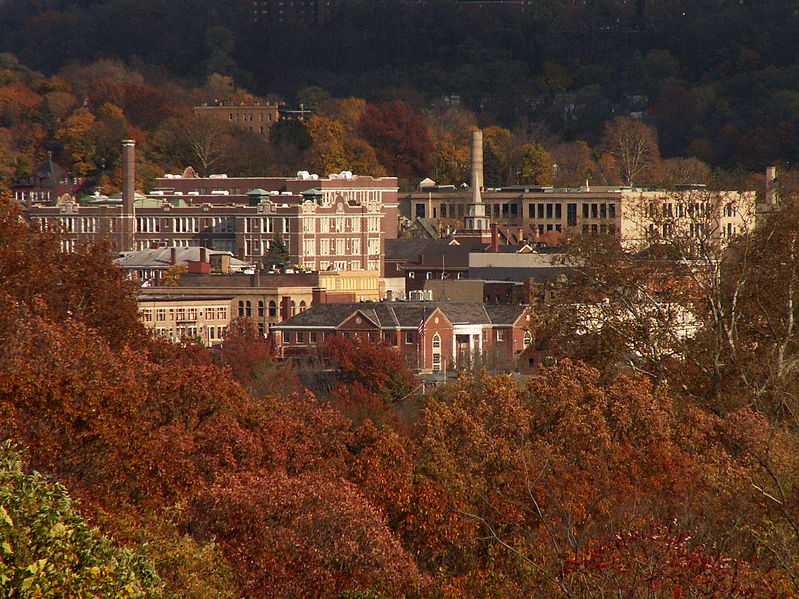
This scraggly groundhog has found an acorn and seems to be thoroughly enjoying it. Groundhogs love to eat grass and—especially—your garden vegetables, but they vary their diet with nuts and other things that appeal to the squirrel in them.

This scraggly groundhog has found an acorn and seems to be thoroughly enjoying it. Groundhogs love to eat grass and—especially—your garden vegetables, but they vary their diet with nuts and other things that appeal to the squirrel in them.

The central business district of Wilkinsburg, vignetted by fall leaves. Among other buildings, we see the municipal building and library (front, red brick with American flag); Wilkinsburg Baptist Church (octagonal tower), the middle and high schools (dark brick), and the old Horner School (light stone).

Garden Croton (Codiaeum variegatum) in the Stove Room, Phipps Conservatory. Like many tropical plants in the horticultural trade, it carries an outdated genus name (Croton) along with it as its common name.
Giuseppe Moretti’s statue of Edward Manning Bigelow stands at the entrance to Schenley Park in Oakland. It was Mr. Bigelow’s persuasive ability that gave us Schenley Park, which was created from the land that had belonged to Mary Schenley, heir to the O’Hara glass fortune; she had left Pittsburgh and was living in England, where Mr. Bigelow went to see her. He fought hard for a park here, a woodland oasis in the middle of the rapidly expanding city, though powerful interests wanted the land for more urban development. Mr. Bigelow also planned several of the broad boulevards that meander through the eastern part of the city: Beechwood Boulevard, Washington Boulevard, and Grant Boulevard, which after his death was renamed Bigelow Boulevard.

This Slovak church is no longer used, but the building is still kept in good condition.

The Romanesque façade, with its colorful inlays, is something extraordinary even in a region of extraordinary churches.


The relief of Ss. Cyril and Methodius, apostles to the Slavs, shows more than a little Art Deco influence.
Until a few years ago, the tower held up a fine statue of St. Joseph the Worker, one of the last major works of the great Frank Vittor. It has been moved to St. Maximilian Kolbe parish, where you can see it at eye level.

This bird is probably the most photographed of her species (Crax globulosa) in the world. She lives in the Wetlands room at the National Aviary, and she has a habit of sidling right up to visitors to see if they have anything good to offer her. Or perhaps she just likes the company. Or—to think more like a bird—perhaps she thinks she needs to keep an eye on us when we encroach on her territory. In the wild, the Wattled Currasow is an endangered species. At the Aviary, though, she lives a pretty soft life.

Update: Some of the information about the architect was wrong in the original version of this article. Back in those days, the Society of Architectural Historians article on this church said, “Little is known about Budapest-born Titus de Bobula.” But Old Pa Pitt has fixed that. Now you can read his article about Titus de Bobula and know way too much.
The cathedral moved farther out into the suburbs (though still in Munhall borough), and this is now the National Carpatho-Rusyn Cultural and Educational Center—an institution that keeps no regular hours and obviously can barely afford to keep the building standing. But the church is loved, and we may hope that whatever love can accomplish will be done for it. The architect was Titus de Bobula, a Hungarian who designed several churches around here. He is a fascinating character: he went back to Hungary in the 1920s and was imprisoned for plotting to overthrow the government; then he came back here and became an arms dealer, while simultaneously working on the designs for the structural aspects of Nikola Tesla’s fantastic, and possibly delusional, electronic superweapons, which of course were never built. It is not often that we find such a direct line from a Carpatho-Rusyn cathedral to the world of science fiction.
Connoisseurs of elegant lettering should not miss the plaque identifying the architect, contractor, and building date. Father Pitt suspects that de Bobula himself designed it: there is nothing else quite like it in Pittsburgh, and the style seems very much like the Art Nouveau of Budapest. (Update: The style is identical to the lettering De Bobula used to sign some of his drawings, so we may be confident that it is his.)


Sculptor Edward Ludwig Albert Pausch designed this equestrian statue, which was unveiled to great fanfare in 1891. It depicts young Colonel Washington, aged 23, as he appeared when he visited the future site of Pittsburgh and nearly drowned himself in the Allegheny. This is apparently known as Pausch’s masterpiece.

If you enlarge the photo above, you will notice that, at the upper right, the name of the Smith Granite Company comes before the sculptor’s name in the signature.


The monument was commissioned by the Junior Order of the United American Mechanics.